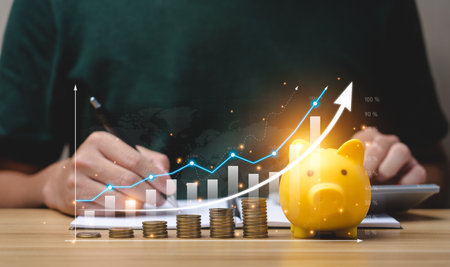What Is Inflation?
Inflation is the rate at which the general level of prices for goods and services rises, eroding purchasing power over time. In simple terms, when inflation occurs, you need more money to buy the same items that used to cost less. This economic phenomenon affects everything from groceries to housing and can have a significant impact on consumers, businesses, and government policies.
Understanding Inflation
Inflation is a natural part of any economy, but it needs to be managed carefully. Moderate inflation is generally considered normal and even beneficial, as it encourages spending and investment. However, excessive inflation can reduce the value of money too quickly, making it difficult for people to afford everyday necessities.
Types of Inflation
There are different types of inflation based on its causes and effects. Here are some common types:
| Type | Description |
|---|---|
| Demand-Pull Inflation | Occurs when demand for goods and services exceeds supply, driving prices higher. |
| Cost-Push Inflation | Happens when production costs increase (e.g., wages or raw materials), leading to higher prices for consumers. |
| Built-In Inflation | Results from businesses raising prices in anticipation of future inflation, creating a self-perpetuating cycle. |
Why Does Inflation Matter?
Inflation directly impacts purchasing power, savings, and economic stability. Here’s why it’s important:
(1) Purchasing Power
As prices rise, the value of money decreases. This means that a dollar today buys fewer goods and services than it did in the past.
(2) Savings & Investments
If inflation outpaces interest rates on savings accounts or investments, the real value of those assets declines over time.
(3) Economic Growth
Moderate inflation encourages spending and borrowing, which fuels economic growth. However, uncontrolled inflation can lead to uncertainty and reduced consumer confidence.
(1) Impact on Consumers
Everyday expenses like groceries, gas, and rent become more expensive, affecting household budgets.
(2) Impact on Businesses
Companies may raise prices or cut costs (such as reducing staff) to cope with rising expenses.
(3) Government Response
The Federal Reserve monitors inflation closely and may adjust interest rates to keep it in check.
Understanding inflation helps individuals make informed financial decisions, whether its budgeting wisely or investing strategically.
2. Causes of Inflation
Inflation occurs when the overall price level of goods and services rises over time, reducing the purchasing power of money. There are three primary drivers of inflation: demand-pull inflation, cost-push inflation, and built-in inflation. Each of these factors contributes to rising prices in different ways.
Demand-Pull Inflation
Demand-pull inflation happens when consumer demand for goods and services exceeds supply. When people have more disposable income or when government spending increases, demand can rise faster than production capacity, leading to higher prices.
Key Causes of Demand-Pull Inflation
- Increased Consumer Spending: When consumers have more money due to wage growth or tax cuts, they tend to spend more, driving up demand.
- Government Spending: Large-scale government projects or stimulus packages can boost demand beyond what the economy can supply.
- Low Interest Rates: When borrowing is cheaper, businesses and individuals take out more loans, increasing spending and investment.
- Strong Economic Growth: A booming economy leads to higher employment rates and greater consumer confidence, causing a surge in demand.
Cost-Push Inflation
Cost-push inflation occurs when the costs of production rise, forcing businesses to increase prices to maintain their profit margins. This type of inflation is often driven by higher wages, increased raw material costs, or supply chain disruptions.
Main Factors Behind Cost-Push Inflation
- Rising Wages: If workers demand higher wages and businesses comply, companies may pass these costs onto consumers through price hikes.
- Increased Raw Material Costs: When essential materials like oil, metals, or agricultural products become more expensive, production costs rise.
- Supply Chain Disruptions: Events like natural disasters, geopolitical conflicts, or pandemics can limit supply and raise costs.
- Higher Taxes and Regulations: New tariffs, taxes, or regulations that increase business expenses can lead to higher consumer prices.
Built-In Inflation
This type of inflation is driven by expectations. When workers anticipate rising prices, they demand higher wages. In turn, businesses raise prices to cover increased labor costs. This cycle continues over time and contributes to ongoing inflation.
The Wage-Price Spiral
The wage-price spiral explains how built-in inflation sustains itself:
| Step | Description |
|---|---|
| (1) Rising Prices | The cost of goods and services increases. |
| (2) Higher Wage Demands | Workers seek higher salaries to keep up with the cost of living. |
| (3) Increased Business Costs | Companies face higher labor expenses and adjust prices accordingly. |
| (4) Continuous Cycle | The process repeats as expectations of inflation persist. |
(1) How Expectations Influence Inflation
If people expect prices to rise in the future, they may spend more now before costs go up. This increased demand can accelerate inflation further.
(2) The Role of Contracts and Agreements
Long-term contracts that include automatic wage increases based on inflation rates contribute to sustained price hikes across industries.
(3) Central Bank Policies
The Federal Reserve monitors inflation expectations closely and adjusts interest rates to control excessive inflationary pressure.

3. Effects of Inflation on Consumers and Businesses
How Inflation Impacts Purchasing Power
Inflation directly affects the purchasing power of consumers by making goods and services more expensive over time. When prices rise faster than wages, people can afford fewer items with the same amount of money. This can lead to a decrease in overall consumer spending, which may slow economic growth.
Impact on Savings
Higher inflation can erode the value of savings. If the interest rate on savings accounts does not keep up with inflation, the real value of money saved decreases over time. For example, if inflation is at 5% annually but a savings account earns only 2% interest, the purchasing power of that savings declines.
Effects on Wages
Wages typically increase over time, but they may not always keep pace with inflation. When wages grow slower than the cost of living, workers experience reduced financial stability. This can lead to demands for higher wages, potentially contributing to further inflation.
Impact on Business Operations
Businesses also face challenges during periods of high inflation. Rising costs for raw materials, labor, and transportation can reduce profit margins. Companies may pass these costs onto consumers by raising prices, which can further fuel inflation. Additionally, uncertainty about future costs may lead businesses to delay investments or expansion plans.
(1) Increased Production Costs
As prices for materials and labor rise, businesses must either absorb the costs or increase their prices. This can make it difficult for small businesses to compete with larger corporations that have more pricing flexibility.
(2) Changes in Consumer Demand
If consumers have less disposable income due to rising prices, they may cut back on non-essential purchases. This shift in demand can impact industries that rely heavily on discretionary spending, such as entertainment and travel.
(3) Higher Interest Rates
The Federal Reserve often raises interest rates to combat high inflation. While this helps control inflation, it also increases borrowing costs for businesses. Higher loan rates can discourage companies from expanding or hiring new employees.
Comparison of Inflation Effects on Consumers and Businesses
| Aspect | Consumers | Businesses |
|---|---|---|
| Purchasing Power | Lowers affordability of goods and services | Makes raw materials and supplies more expensive |
| Savings | Erodes value if interest rates don’t keep up | Affects long-term financial planning |
| Wages & Employment | If wages don’t rise with inflation, financial strain increases | Might need to raise wages or reduce workforce |
| Borrowing Costs | Makes loans and mortgages more expensive | Higher interest rates limit expansion opportunities |
4. How Inflation Is Measured in the U.S.
Inflation is measured using several key economic indicators that track changes in prices over time. In the United States, two of the most commonly used tools are the Consumer Price Index (CPI) and the Producer Price Index (PPI). These indices help economists, policymakers, and businesses understand how inflation affects consumers and producers.
Consumer Price Index (CPI)
The Consumer Price Index (CPI) is one of the most widely used measures of inflation. It tracks changes in the prices of a basket of goods and services that households typically purchase. The CPI is reported monthly by the Bureau of Labor Statistics (BLS) and reflects price movements across categories such as food, housing, transportation, and healthcare.
How CPI Is Calculated
The BLS collects price data from various retail stores, service providers, and online sources to track changes over time. The CPI calculation follows these steps:
- Selecting a representative basket of goods and services
- Tracking price changes for these items over time
- Calculating weighted averages based on consumer spending patterns
- Comparing current prices to previous periods to determine inflation rates
CPI Categories
| Category | Examples |
|---|---|
| Food & Beverages | Groceries, dining out |
| Housing | Rent, utilities |
| Transportation | Gasoline, public transit |
| Medical Care | Doctor visits, prescriptions |
| Recreation | Entertainment, hobbies |
| Education & Communication | Tuition, internet services |
| Apparel | Clothing, footwear |
| Other Goods & Services | Tobacco, personal care items |
Producer Price Index (PPI)
The Producer Price Index (PPI) measures inflation from the perspective of producers. Instead of tracking what consumers pay for goods and services, PPI focuses on the wholesale prices businesses receive for their products at different stages of production.
PPI vs. CPI: Key Differences
| Factor | PPI | CPI |
|---|---|---|
| Main Focus | Wholesale prices paid to producers | Retail prices paid by consumers |
| Covers Which Sector? | B2B (Business-to-Business) | B2C (Business-to-Consumer) |
| Affects Who? | Sellers, manufacturers, suppliers | The general public, households |
| Main Use Case | An early indicator of inflation trends | A measure of cost-of-living changes |
PPI Measurement Process
The Bureau of Labor Statistics collects data from thousands of businesses across different industries. PPI is divided into three primary stages:
- PPI for Finished Goods – Measures prices for final products ready for sale.
- PPI for Intermediate Goods – Tracks costs of materials used in production.
- PPI for Crude Materials – Monitors raw material price fluctuations.
The Role of Inflation Measurement in Economic Policy
CPI and PPI provide essential insights into inflation trends. Policymakers use these indices to make decisions about interest rates, wage policies, and government programs. Businesses also rely on this data to adjust pricing strategies and plan for future expenses.
5. Ways to Manage and Hedge Against Inflation
Inflation can erode the purchasing power of money over time, making it essential for individuals and businesses to take proactive steps to protect their financial well-being. Below are some strategies to manage and hedge against inflation effectively.
Investing in Inflation-Protected Assets
Certain investments are designed to help preserve value during inflationary periods. Consider these options:
- Treasury Inflation-Protected Securities (TIPS): U.S. government bonds that adjust with inflation.
- Real Estate: Property values and rental income often rise with inflation.
- Commodities: Gold, silver, and other tangible assets tend to retain value as prices increase.
- Stocks: Companies that can pass higher costs onto consumers may perform well during inflationary times.
Diversifying Income Sources
Relying on a single source of income can be risky when inflation rises. Consider these diversification strategies:
- Side Businesses or Freelancing: Earning extra income through side gigs can help offset rising costs.
- Dividend Stocks: Investing in dividend-paying stocks provides passive income that may grow over time.
- Rental Income: Owning rental properties can generate consistent cash flow that adjusts with inflation.
Reducing Debt with Fixed Interest Rates
If you have debt, managing it wisely can help mitigate the impact of inflation:
- Fixed-Rate Loans: Locking in low interest rates prevents rising borrowing costs.
- Avoid Variable-Rate Debt: Interest rates on variable loans may increase as inflation rises.
- Pay Down High-Interest Debt: Reducing expensive debt frees up more money for investments.
Adjusting Budget and Expenses
Inflation affects daily expenses, so adapting your budget is crucial:
| Category | Strategy |
|---|---|
| Housing Costs | Consider refinancing a mortgage at a lower fixed rate if possible. |
| Groceries & Essentials | Buy in bulk, use coupons, and switch to cost-effective brands. |
| Transportation | Use public transport or carpool to reduce fuel expenses. |
| Savings & Investments | Avoid holding excessive cash; invest in assets that outpace inflation. |
Navigating Business Strategies Against Inflation
If you run a business, taking these steps can help mitigate inflations impact:
- Adjust Pricing Strategically: Gradually increase prices to reflect rising costs while maintaining customer trust.
- Diversify Suppliers: Reduce reliance on a single supplier to avoid price shocks.
- Improve Efficiency: Streamline operations to cut unnecessary costs without sacrificing quality.
- Add Value for Customers: Offer bundled services or loyalty programs to maintain demand despite price adjustments.
The Importance of Staying Informed
A good understanding of economic trends helps individuals and businesses make informed financial decisions. Follow reliable sources such as:
- The Federal Reserve’s reports on monetary policy and inflation data.
- Bureau of Labor Statistics updates on the Consumer Price Index (CPI).
- Earnings reports from companies in key industries affected by inflation.
- Economic forecasts from financial analysts and investment firms.
Taking proactive steps today can help safeguard your finances from the effects of inflation, ensuring long-term stability and growth.


